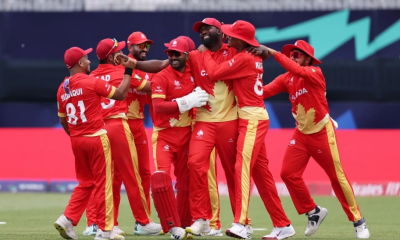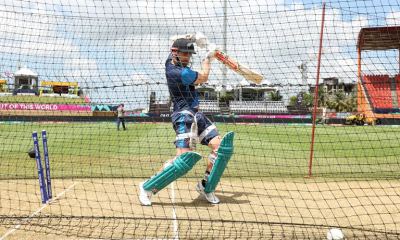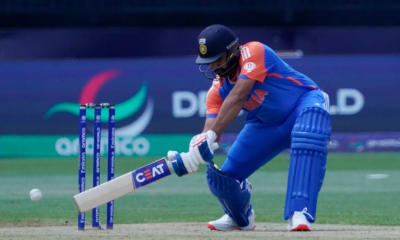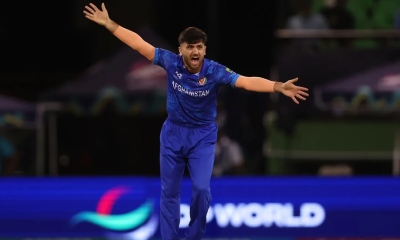Sports
Adair rips through Afghanistan to give Ireland opening-day honours
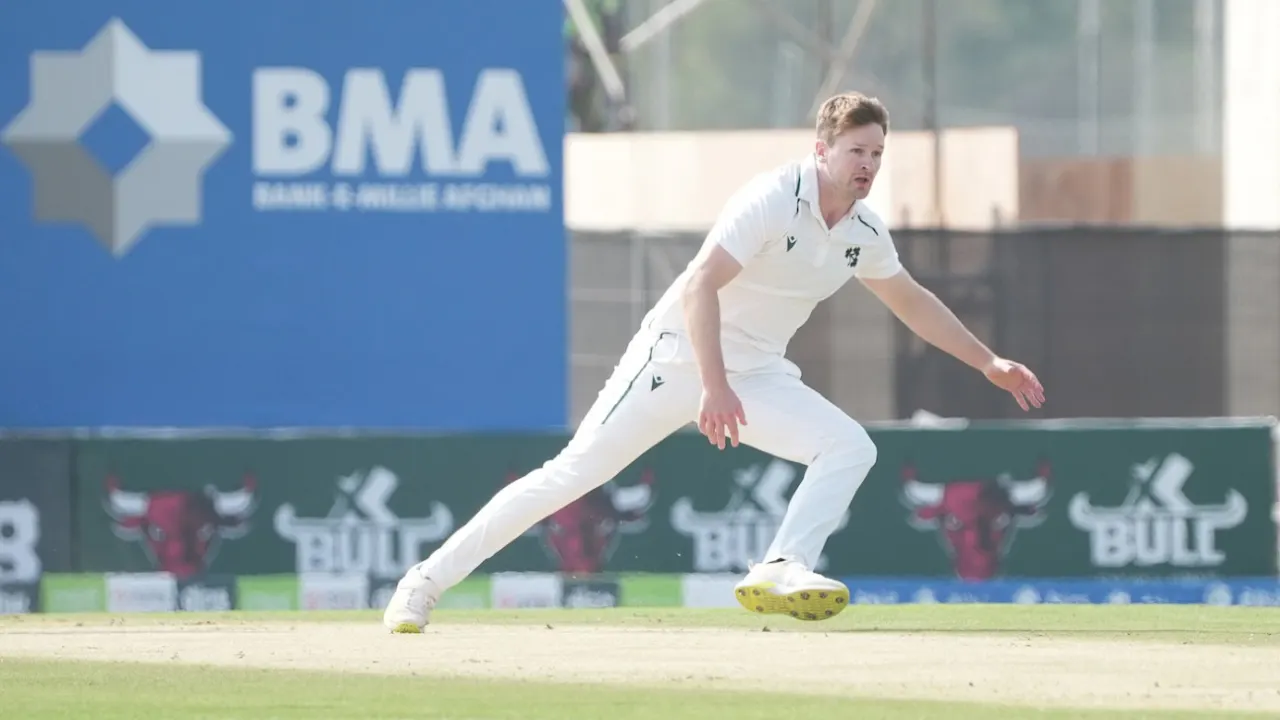
A Test match had never been played at Tolerance Oval in Abu Dhabi before, so the conditions were a bit of an unknown for both Afghanistan and Ireland. Even then, neither side could have expected so much sharp, conventional swing, until a stage when reverse swing became a bigger factor. There was movement on offer off the pitch, too. Add to that the accuracy of Ireland’s quick bowlers, led by Mark Adair saw all ten Afghanistan wickets fell inside 55 overs.
Hashmatullah Shahidi had opted to bat under a bright and sunny sky, hoping for spin to play a part when they would bowl in the fourth innings of the Test. But, by the end of day one, Afghanistan were only 55 ahead, with six Ireland wickets remaining.
Ireland’s third-wicket pair of Curtis Campher and Harry Tector added 60 after they were 32 for 2 in the tenth over.
Afghanistan themselves were 11 for 2 after seven overs. Ibrahim Zadran and Shahidi had repaired their innings with a 55-run stand, which was broken when Shahidi tickled one down leg off one of Ireland’s three debutants, Brian McCarthy. Ibrahim and Afghanistan’s only debutant, Rahmanullah Gurbaz, then added 22 more. But at 86 for 3 just after lunch, the wheels started to come off for Afghanistan. And the trigger was pressed by Adair, who had already picked up two out of the three wickets until then. The first of those had come in the third ball of the seventh over when Adair had Noor Ali Zadran nicking to second slip.
Two deliveries later, Ireland reviewed when an lbw shout by Adair against Rahmat Shah went against them, only for replays to show the ball missing leg. But next ball, Adair cleaned Rahmat up for a duck, when a length ball angled in and straightened to find the gap between bat and pad. Adair also struck in the second over after lunch, having Gurbaz bottom edge one to the wicketkeeper.
Two of Adair’s other victims were Zia-ur-Rehman, who flashed one to second slip to end a stay of more misses than hits, and Zahir Khan, for whom Adair perhaps reserved his best of the lot. Coming from around the wicket to the left-hander, Adair landed one on a length around off, and got the ball to straighten to hit the top of off.
Adair’s five-for aside, debutant Craig Young and Campher picked up two wickets each. The most important of those was that of Ibrahim, who, like his captain Shahidi, ended up clipping down the leg side for a catch to the wicketkeeper. Until then, he had scored 53 of the 90 runs on the board. His departure gave Young his second wicket after he had bowled Nasir Jamal for a duck.
Campher, meanwhile, helped clean the tail up, striking twice in the 50th over after Naveed Zadran had frustrated Ireland for 42 balls.
Andy Balbirnie got a life in the second over when Rahmat dropped a simple catch off Naveed at gully. But Naveed ended his stay in his next over, pinning him in front. Balbirnie’s review proved to be futile as ball-tracking confirmed that the ball would have hit the middle of leg. Campher came in at No. 3 after that early blow and had a big role to play in how the day panned out.
More luck was due for Ireland except that they couldn’t capitalise. Peter Moor, Ireland’s other opening batter, was playing only his second Test for his adopted country. He had managed only 10 and 11 in his first, and when on 10 in the sixth over, he was cleaned up by Naveed by one that came back in sharply from outside off. But halfway to the pavilion, he was called back because Naveed’s front foot had crossed the line.
And off the final legal delivery of the sixth over, Moor – still on 10 – was ruled out lbw but he used the DRS to reverse the decision. But he couldn’t make it count as he chopped Naveen on to his stumps for 12 in the tenth over.
That is when Campher and Tector joined hands. Runs came at a steady pace for Ireland, with Campher leading the way. He hit 25 off his first 17 balls, including five boundaries. Tector was calmer at the other end, ticking off singles.
But in a late twist to the day, left-arm spinner Zia got Campher to nick behind to Gurbaz for 49. Two overs later, nightwatcher and the third of Ireland’s first-timers, Theo van Woerkom, was bowled for 1 with what was a classical delivery that drifted in and turned away.
However, Tector and Paul Stirling took Ireland to the end of the day without further damage.
Brief scores:
Afghanistan 155 in 54.5 overs (Ibrahim Zadran 53, Hashmatullah Shahidi 20, Karim Janat 41*; Mark Adair 5-39, Craig Young 2-31, Curtis Campher 2-13) lead Ireland 100/4 in 31 overs (Curtis Campher 49, Harry Tector 32*, Naveen Zadran 2-32, Zia-ur-Rehman 2-13) by 55 runs
(Cricinfo)
Sports
England face Australia in the battle of champions
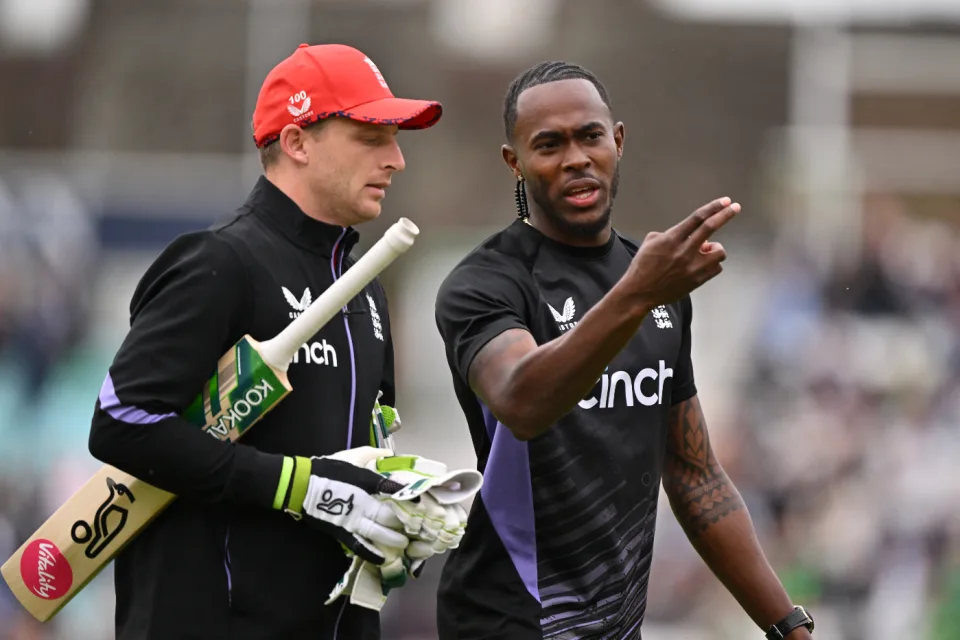
The first truly heavyweight clash of this expanded T20 World Cup format comes freighted with both history and subplots. A rematch of the 2010 World T20 final at Kensington Oval, the match pits Jos Buttler’s defending champions – who are aiming to become the first team to retain the trophy – against the Australian winning machine, victors at the 2021 edition and current world title-holders in Test and ODI cricket. And that’s before you throw in the Ashes for afters.
Already there is added pressure on England, after the rain in Bridgetown led to a share of the points in their opener against Scotland (and that having conceded 90 runs from 10 overs without taking a wicket in a tepid bowling display). Lose to their oldest rivals and it will leave their Super 8 prospects open to being waylaid by the perils of net run-rate calculations, or worse.
The Scotland match was the third abandonment in five suffered by England, after a rain-affected home series against Pakistan, which has clearly hampered their readiness for this campaign after almost six months without playing T20 together. It does not take much for a side to click in this format – and England looked in decent shape when they did get on the field against Pakistan – but Buttler will be anxious for things to go their way on Saturday, if only to avoid further questions referencing the team’s disastrous ODI World Cup defence last year.
Australia, under the laidback leadership of Mitchell Marsh would love nothing more than to add to the English sense of jeopardy – having helped bundle them out of the tournament in India on the way to taking the crown. Their head to head record is less impressive in T20 however, with England having won six of the last seven completed encounters, as well as that 2010 final.
Despite a wobble with the bat, Australia avoided mishap against Oman earlier in the week, the experience of David Warner and Marcus Stoinis shining through in difficult batting conditions. Surfaces in the Caribbean – not to mention those games staged in the USA – have already had teams scratching their heads; rather than the “slug-fest” England had prepared for, following a high-scoring tour of the Caribbean in December, it looks as if boxing smart may be the way to go.
Speaking of Warner, this could be the last time he faces up against England in national colours – and another match-winning contribution would likely reduce the chances of them meeting again in the knockouts. On the other side of the card is Jofra Archer, fresh from an emotional maiden outing at Kensington Oval and ready to take on Australia for the first time in any format since 2020. Can Mark Wood fire up England’s campaign, as he did during last summer’s Ashes? Will Pat Cummins be back to harass the old enemy once again? Seconds out, it’s almost time to rumble.
Cummins is set to return after being rested for the Oman game, which saw Mitchell Starc leave the field with cramp. Starc is understood to be fine and could keep his place – which would likely see Nathan Ellis miss out. Marsh is still not fit to bowl, with Australia likely to continue with the allrounder combination of Stoinis and Maxwell to give them cover.
Australia (probable XI): David Warner, Travis Head, Mitchell Marsh (capt), Glenn Maxwell, Marcus Stoinis, Josh Inglis (wk), Tim David, Pat Cummins, Nathan Ellis/Mitchell Starc, Adam Zampa, Josh Hazlewood
The one change England may consider is Reece Topley coming in for Wood, with the expectation that there will be some rotation among the seamers through the course of the tournament.
England (probable XI): Phil Salt, Jos Buttler (capt & wk), Will Jacks, Jonny Bairstow, Harry Brook, Liam Livingstone, Moeen Ali, Chris Jordan, Jofra Archer, Adil Rashid, Reece Topley/Mark Wood
[Cricinfo]
Sports
South Africa up against their bogey team in batter-unfriendly New York

Once is coincidence, twice is a clue, and three times is proof.
To paraphrase Agatha Christie, that is the narrative around South Africa’s meeting with Netherlands at this T20 World Cup.
The Dutch beat South Africa at the 2022 tournament and ended their semi-final hopes in a match where South Africa appeared to be sleep walking, and then beat them again at the 2023 ODI World Cup, where they exposed South Africa’s vulnerability in the chase. If they to do the treble, not only will Netherlands take the lead in Group D, but they will offer conclusive evidence of the threat they pose to Full Members, especially South Africa.
Of course, it will take some doing after South Africa’s opening performance against Sri Lanka, where they reduced their opposition to their lowest T20I total and chased it down in fairly straightforward fashion thanks to the most stable middle-order of their white-ball era. In Aiden Markram, Tristan Stubbs, Heinrich Klaasen and David Miller, South Africa have bankers and big-hitters and, for this match, they also have the advantage of experience. They’ve already played at Eisenhower Park, and have first-hand knowledge that run-scoring doesn’t come easily;Klassen said they are prepared to use their “cricket brains” and play “smarter cricket”.
But the conditions could be good news for Netherlands, who are not naturally a line-up of big hitters and build their innings on a foundation of turning ones into twos. In other words, they tend to take a slightly more conservative approach to batting, which may work well here, but they’ll be wary of the uneven bounce of the surface and will have to come up with plans to counterattack especially against South Africa’s seamers. Their own bowlers were exemplary in Dallas and will look to build on that performance against a line-up that will likely be more proactive than Nepal’s, but who they have managed to keep quiet not once, but twice in the past. Third time’s the charm, they say.
Anrich Nortje’s stunning return to form against Sri Lanka means South Africa may not have to tinker with the bowling combination, and Gerald Coetzee and Tabraiz Shamsi may have to wait their turns to get a game. The batting line-up should be unchanged, with no space for Ryan Rickelton yet.
South Africa: Quinton de Kock (wk), Reeza Hendricks, Aiden Markam, Tristan Stubbs, Heinrich Klaasen (wk), David Miller, Marco Jansen, Keshav Maharaj, Kagiso Rabada, Ottneil Baartman, Anrich Nortje
Conditions in New York may tempt Netherlands to include an extra seamer and they have Kyle Klein in their squad. But it could come at the expense of a shortened batting line-up and they may not want to risk that.
Netherlands: Michael Levitt, Max O’Dowd, Vikramjit Singh, Sybrand Engelbrecht, Scott Edwards (capt, wk), Bas de Leede, Teja Nidamanuru, Logan van Beek, Tim Pringle, Paul van Meekeren, Vivian Kingma
[Cricinfo]
Latest News
Mustafizur, Rishad, Hridoy dazzle in Bangladesh’s tight two-wicket win over Sri Lanka
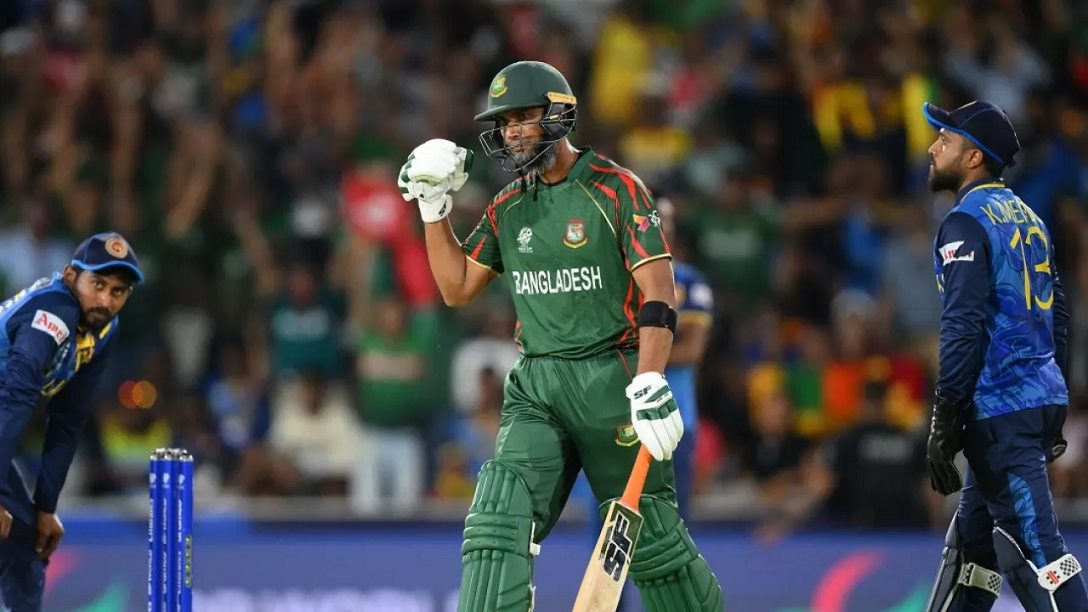
Nuwan Thushara’s last over brought Sri Lanka screaming back into the match,as he first bowled Rishad Hossain, and then nailed Taskin Ahmed in front of the stumps with a pinpoint swinging yorker. This left Bangladesh eight wickets down, with 12 runs still to get.
However, the experienced Mahmudullah was at the crease for Bangladesh, and despite some further nervy moments, pushed Bangladesh across the line off the last ball of the 19th over.
But this was a match chiefly decided by Bangladesh’s own outstanding bowling. Mustafizur Rahman was the best among them, using shorter lengths and his cutters efficiently, to claim figures of 3 for 17. Rishad Hossain’s three-for through the middle overs also kept Sri Lanka quiet.
Mustafizur was instrumental in Sri Lanka’s downward spiral through the middle overs, which culminated in a crash-and-burn end. Ultimately, their inability to find boundaries, or even rotate strike against good Bangladesh bowling resulted in their downfall. A score of 125 for 9 always seemed poor on a decent pitch, even if their bowlers made a match of it in the end.
Brief scores:
Bangladesh 125 for 8 in 19 overs (Towhid Hridoy 40, Litton Das 36; Dhanajaya de Silva 1-11, Nuwan Thushara 4-18, Wanidu Hasaranga 2-32, Matheesha Pathirana 1-27) beat Sri Lanka124 for 9 in 20 overs (Pathum Nissanka 47, Dhananjaya de Silva 21; Tanzim Hasan Sakib 1-24, Taskin Ahmed 2-25, Mustafizur Rahman 3-17, Rishad Hossain 3-22) by two wickets
[Cricinfo]


